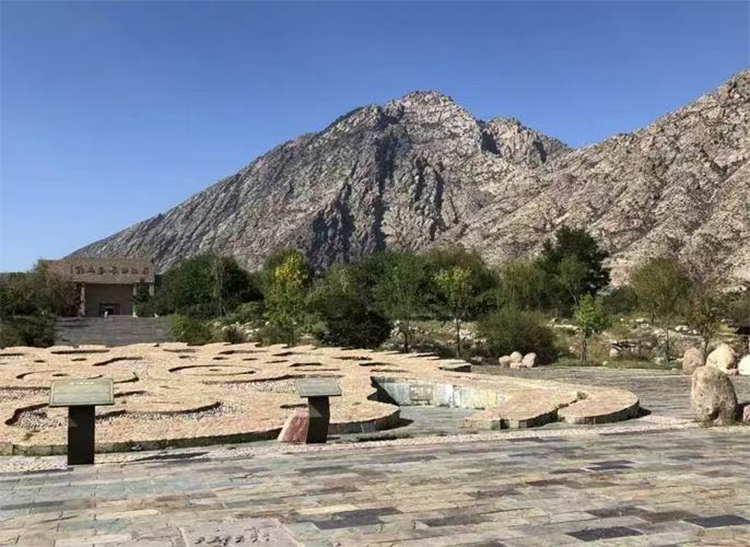Helankou Rock Paintings: Visitor Guide to Helan Mountain Petroglyphs
Introduction
When morning light washes over Helan Mountain’s rugged cliffs, millennia-old chiselled marks seem to wake: hunting warriors, frenzied ritual dancers, and mysterious solar totems whisper ancient stories on weathered stone. Helan’s petroglyphs are more than archaeological remains — they form an open-air archive of human civilization. With over 20,000 bold images spanning from the Neolithic to the Western Xia dynasty, this rock-art corridor unlocks the spiritual world of northern nomadic peoples.
1. Soul Imprints: The Millennial Code on Stone
The “Sun Deity” motif is among Helan’s most striking symbols: concentric, double-ringed eyes gazing skyward, with 24 rays radiating like flames. Dated between about 3,000 and 10,000 years old, archaeologists interpret this totem as an expression of early people’s awe of cosmic forces. Other panels vividly record daily life: herds of argali fleeing spears, feather-crowned shamans kneeling in ritual, and rare scenes of battle or intimate moments.
These carvings — concentrated in some 30 valleys, with the Helankou rock art cluster especially dense — were made with primitive stone tools. Their simple lines, full of vitality, make these panels a textbook of northern Chinese rock art.
Designated a Major National Cultural Heritage Site, each petroglyph panel at Helan is a palimpsest of overlapping cultures: Xiongnu, Xianbei, Tangut and others left marks here, and the Western Xia sometimes incorporated local motifs into their religious art. Standing beneath the cliff and running a hand over the grooves, you feel not just the stone’s chill but a cultural tremor that crosses time.
2. Seasonal Pilgrimage: Light and Shadow on Gobi Cliffs
Best months to visit: May–October. Late-spring wildflowers adorn brown-red cliffs; clear summer skies emphasize the carvings’ three-dimensional forms; autumn’s deep blue skies and golden grass create a natural frame. After rain, the damp stone makes carvings especially legible; in winter, snow-clad ridges transform the landscape into an ink-wash painting.
Photo enthusiasts should target two golden windows:
– Sunrise (approx. 06:00–07:30): low-angle light dramatizes the Sun Deity’s 24 rays with long shadows.
– Sunset (approx. 17:30–19:00): evening glow bathes the cliff in amber, animating the human faces and figures.

3. Deeper Experiences: From Sightseeing to Cultural Immersion
– Rock-art decoding hike (2–3 hours): a 3 km walk along the Helankou ravine. With a professional guide you’ll learn to identify hunting scenes, totemic signs and Western Xia inscriptions.
– Starry-night tours (summer only): in the valley’s dark skies, use red-filtered lights to view carvings while the Milky Way arcs overhead.
– Intangible-heritage workshops: at the park’s cultural center try stone-rubbing techniques to copy designs, or join leather-carving sessions inspired by petroglyph motifs.
If you prefer less walking, an electric shuttle (included in the ticket) takes visitors to the core area, but exploring on foot reveals hidden “easter egg” panels high on the cliff faces.
4. Practical Guide: Getting There and Visitor Tips
– Location: about 50 km from central Yinchuan, roughly a 1-hour drive.
– Transport:
– By car: navigate to “Helan Mountain Rock Art Site Park.” Parking fee: 10 yuan per vehicle.
– By bus: depart Yinchuan Tourist Bus Station on Tour Bus No. 2 (one departure hourly; fare 15 yuan).
– Tickets & hours:
– Full ticket 70 yuan (includes electric shuttle); student half price.
– Peak season (May–Oct) 08:30–18:00; off-season closes one hour earlier.
– Tip: free bilingual (Chinese/English) guided talk available daily at 14:00.

Conclusion
Helan Mountain’s petroglyphs are not cold stone but an epic carved by time and human hands. When a modern traveler’s reflection overlaps with these millennial images, it feels like a handshake across civilizations. If your China itinerary seeks experiences beyond ordinary attractions, Helan speaks in the most primal artistic language about belief, survival and beauty.


